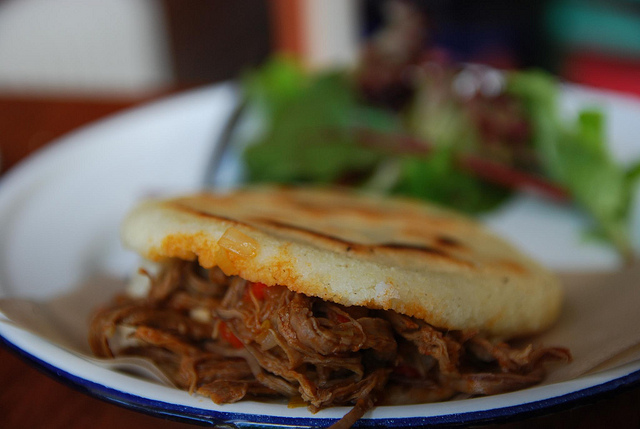Snacking is a way of life for life for US consumers, and as restaurants and food manufacturers seek to expand their snack offerings many of them are turning to Latin American foods and flavors for inspiration. Eighty-three percent of consumers surveyed this year said they snack on a daily basis, up from 73% in 2014, according to research from Technomic.
The practice of eating several snacks or “mini-meals” throughout the day is catching on, and food companies are introducing more on-the-go options such as chips, vegetable-based snacks, beverages and handheld items that offer the nutrition and satiety of a meal in a convenient package. Latin American cuisine is full of examples of these types of foods — from fresh fruits and vegetables cut into bite-sized pieces for easy snacking to popular street foods such as empanadas and tacos. In addition to offering their take on these traditional Latin American snacks, restaurants and food brands are also using the formats and ingredients common in Latin American cuisine to create innovative new snack options.
Latin snacks in foodservice: from food trucks to fine dining
The popularity of snacking seems to know no bounds, and eateries of all types are answering the call with smaller portions or shareable items. Tacos appear on 25% of US menus and have seen steady growth since 2005, according to Datassential, which also reports an upward trend for empanadas, which have grown 119% over the last 10 years.
“Latin American snacks always seem standard on appetizer menus,” said chef Julian Medina, whose restaurants include Tacuba and Yerba Buena in New York City.
“Empanadas, tacos, ceviches — Latin America knows how to create incredible flavor in small dishes. My favorite are tacos and I offer a plethora of different tacos on all my menus. One in particular to mention is my Tacos de Chapulines as it is a snack in a street food! Chapulines are dry grasshoppers which are eaten like popcorn in Mexico,” Medina said.
Churros, one of the most common Latin American street foods, appear on a wide range of menus, from quickservice to fine dining. The fried pastries have grown 96% on menus since 2005, according to Datassential, which reports 40% of consumers have tried churros and 28% want to try them. The options go well beyond the traditional cinnamon-sugar flavor and include filled churros and the Oreo churros manufactured for foodservice by J&J Snack Foods.
Food trucks are helping boost the popularity of Latin snacks and street foods by offering authentic options such as pastels and aguas frescas that go beyond Americanized dishes like tacos or fajitas, according to Datassential.
On the shelf: packaged snacks and beverages
Latin American foods and flavors are a growing presence in the grocery aisle, thanks to increasing consumer interest in global foods and Latino consumers’ growing purchasing power in the US, Food Business News reports. Cookies, chips and other snacks from brands such as Bimbo and Takis that are popular in Mexico and Central and South America are growing their reach in the US. Additionally, US food and beverage manufacturers are using traditional Latin American snacks and drinks to inspire new products.
Latin American ingredients such as quinoa, amaranth, purple corn and purple potatoes are seeing a surge in popularity due to their health benefits and wide range of applications in snack foods, according to Packaged Facts’ 2014 Culinary Trend Tracking Series report on South American flavors.
Quinoa and amaranth are often used in breakfast and snack bars. Chips made with purple corn and purple potatoes are not an uncommon sight, and both ingredients are also gaining popularity with beverage manufacturers. Honest Tea uses purple potato juice as a natural dye in its Honest Zero Organic Passion Fruit Green Tea with Maqui Berry, and a few brands produce bottled chicha morada, a Peruvian drink made from purple corn.
What’s next: flavors and formats of the future
As Latin American formats and ingredients become commonplace on all types of menus and in all sorts of packaged snack products, some chefs and manufacturers are looking ahead to the next trend.
Medina predicts arepas will be the next Latin American dish to make it into the mainstream. “Similar to sliders, arepas are two-bite sandwiches with a cornmeal biscuit and savory filling from Colombia and Venezula. I can see US diners truly enjoying this dish. Also, tostadas which are fried corn tortillas topped with various ingredients — they can be light with ceviche or heartier with meats,” he said.
Various takes on llapingacho — a close relative of the arepa made with potatoes — are expected to show up on more US menus as restaurant concepts push potatoes to the center of the plate, according to a 2014 report from Packaged Facts on street and grill foods. “Llapingachos are not yet available commercially but can easily be formulated for refrigerated and frozen sale to consumers because of their potato-cheese composition,” Research Director David Sprinkle wrrote in the report.
Sopes, a traditional Mexican dish of fried corn masa piled with various toppings, also have potential for mainstream popularity, chef Claud Beltran said during a panel at the Culinary Institute of America’s 18th annual Worlds of Flavor conference earlier this year.
__________________________________________________
If you enjoyed this article, join SmartBrief’s email list for more stories about the food and beverage industry. We offer 14 newsletters covering the industry from restaurants to food manufacturing.
